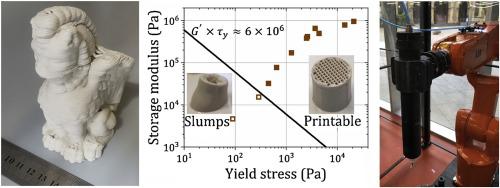Additive Manufacturing ( IF 10.3 ) Pub Date : 2020-05-20 , DOI: 10.1016/j.addma.2020.101335 Shareen S.L. Chan , Ryan M. Pennings , Lewis Edwards , George V. Franks

|
The effect of varying the solids volume fraction of an aqueous clay paste suspension on its printability via an Additive Manufacturing (AM) or 3D printing technique, Direct Ink Writing (DIW) or material extrusion, has been studied. DIW is a cost-effective and straightforward fabrication technology suitable for adoption at a larger scale by the traditional ceramics industry and the creative community. The pastes were prepared with volume fraction of solids ranging from 25–57 vol%. Their rheological properties (storage modulus and apparent yield stress) were measured by dynamic oscillatory rheometry. The relationships between solids content, rheological behaviour and print parameters were evaluated. An equation based on rheological properties to delineate between printable and non-printable conditions has been proposed. Several decorative pieces have been produced for architectural purposes.
中文翻译:

用于装饰建筑应用的粘土的3D打印:固体体积分数对流变性和可印刷性的影响
已经研究了通过增材制造(AM)或3D打印技术,直接墨水书写(DIW)或材料挤出来改变水性粘土糊状悬浮液的固体体积分数对其可印刷性的影响。DIW是一种经济高效且直接的制造技术,适合于传统陶瓷行业和创意界更大规模地采用。制备的糊状物的固含量为25-57%(体积)。通过动态振荡流变法测量它们的流变性质(储能模量和表观屈服应力)。评估了固含量,流变行为和印刷参数之间的关系。已经提出了一种基于流变性质的可在可印刷和不可印刷条件之间划定的方程。











































 京公网安备 11010802027423号
京公网安备 11010802027423号